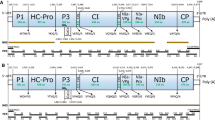Abstract
Cardamom mosaic virus, a possible member of the family Potyviridae has been associated with the mosaic disease (Katte disease) of small cardamom in India. A virus isolated from the symptomatic cardamom leaves was positive in ELISA only with antiserum to the Guatemalan isolate of cardamom mosaic virus and not with a number of other potyviruses. The size of the viral RNA (8.5 kb) and the molecular weight of the coat protein (CP) (38 kDa) were determined. A 1.8-kb product containing the partial nuclear inclusion body (NIb) gene, the entire coat protein gene and the 3′ untranslated region (UTR) was amplified by reverse transcription (RT) and polymerase chain reaction (PCR), cloned and sequenced. The viral origin of the clone was confirmed by Northern hybridization with viral RNA. The experimentally determined N-terminal sequence of the CP matched with the deduced amino acid sequence of the CP gene. Sequence analysis of the clone suggests that the cardamom mosaic virus is a member of the Macluravirus genus of the family Potyviridae.
Similar content being viewed by others
References
Brunt A.A., Crabtree K., Dallwitz M.J., Gibbs A.J., and Watson L., Viruses of Plants — Description and Lists from the VIDE Database. CAB International, Wallingford, UK, 1996, pp. 233-234.
Saravanakumar M., Panicker S., and Usha R., Indian J Virol 14, 59-63, 1998.
Saju K.A., Venugopal M.N., and Mathew M.J., XII Annual convention — Abstract. Indian Virological Society, p.15, 1997.
Varma P.M. and Capoor S.P., Indian J Agric Sci 28, 97-107, 1958.
Varmudi V., Spice India: Directorate of Economics and Statistics. New Delhi, April 2000, pp. 13-15.
Uppal B.N., Varma P.M., and Capoor S.P., Curr Sci 14, 208-209, 1945.
Rajan P., J Plantation Crops 9, 34-41, 1981.
Naidu R. and Venugopal M.N., J Plantation Crops 16, 267-271, 1986.
Saigopal D.V.R., Naidu R., and Thomas J., J Plantation Crops 20, 73-75, 1992.
Gonsalves D., Trujillo E., and Hoch H.C., Plant Dis 70, 65-69, 1986.
Martin R.R. and Bristow P.R., Phytopathology 78, 1636-1640, 1988.
Laemmli U.K., Nature 227, 680-685, 1970
Mishra A., McKimm-Breschkin J.L., Xiao X.W., and Shukla D.D., Indian J Virol 13(1), 15-22, 1997.
Mowat W.P. and Dawson S., J Virol Methods 15, 233-247, 1987.
Farrcll R.E. Jr, RNA Methodologies: A Laboratory Guide for Isolation and Characterization. Academic Press, San Diego, 1993.
Carninci P., Nishiyama Y., Westover A., Itoh M., Nagaoka S., Sasaki N., Okazaki Y., Muramatsu M., and Hayashizaki Y., Proc Natl Acad Sci USA 95, 520-524, 1998.
Gibbs A. and Mackenzie A., J Virol Methods 63, 9-16, 1997.
Thompson J.D., Higgins D.G., and Gibson T.J., Nucleic Acids Res 22, 4673-4680, 1994.
Felsenstein J., PHYLIP-Phylogeny Interphase Package (version 3.5c) http://evolution.genetics.washington.edu/phylip.html
Shukla D.D. and Ward C.W., Adv Virus Res 36, 273-314, 1989.
Ravi K.S., Joseph J., Nagaraju N., Prasad K.S., Reddy H.R., and Savithri H.S., Plant Dis 81, 673-676, 1997.
Badge J., Robinson D.J., Brunt A.A., and Foster G.D., J Gen Virol 78, 253-257, 1997.
Shukla D.D., Ward C.W., and Brunt A.A., The Potyviridae, CAB International, Wallingford, 1994.
Carrington J.C. and Dougherty W.G., Proc Natl. Acad Sci USA 85, 3391-3395, 1988.
Argos, P., Nucleic Acids Res 16, 9909-9916, 1988.
Jacquet C., Delecolle B., Raccah B., Lecoq H., Dunez J., and Ravelonandro M., J Gen Virol 79, 1509-1517, 1998.
Harrison B.D. and Robinson D.J., Molecular variation in vectorborne plant viruses: epidemiological significance. Philos Trans R Soc Lond B 321, 447-462, 1988.
Hall J.S., Adams B., Parsons T.J., French R., Lane L.C., and Jensen S.G., Mol Phylogenet Evol 10(3), 323-332, 1998.
Shukla D.D. and Ward C.W., J Gen Virol 69, 2703-2710, 1988.
Author information
Authors and Affiliations
Rights and permissions
About this article
Cite this article
Jacob, T., Usha, R. 3′-Terminal Sequence analysis of the RNA Genome of the Indian Isolate of Cardamom Mosaic Virus: A New Member of Genus macluravirus of potyviridae. Virus Genes 23, 81–88 (2001). https://doi.org/10.1023/A:1011191614839
Issue Date:
DOI: https://doi.org/10.1023/A:1011191614839




